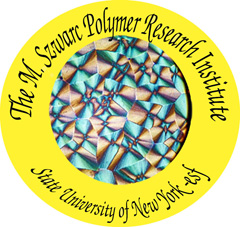SUNY ESF
Polymer Research Institute
The Michael M. Szwarc Polymer Research Institute (PRI)
Mission and Objectives
 The Michael M. Szwarc Polymer Research Institute is a consortium of associate members
drawn from several organizations and institutions. It was established to promote the
advancement of polymer science through education and research, coordinate diversified
activities of polymer scientists and engineers in the Central New York area, and develop
strong cooperative programs with polymer-based industries nationwide. Among its activities
are sponsorship of new educational and research ventures, encouragement of individual
and cooperative research programs, participation in academic programs leading to the
B.S., M.S. and Ph.D. degrees, and promotion of continuing education and new developmental
opportunities for scientists. The Institute will engage in all other activities necessary
to maintain itself as a center of excellence in polymer science and engineering.
The Michael M. Szwarc Polymer Research Institute is a consortium of associate members
drawn from several organizations and institutions. It was established to promote the
advancement of polymer science through education and research, coordinate diversified
activities of polymer scientists and engineers in the Central New York area, and develop
strong cooperative programs with polymer-based industries nationwide. Among its activities
are sponsorship of new educational and research ventures, encouragement of individual
and cooperative research programs, participation in academic programs leading to the
B.S., M.S. and Ph.D. degrees, and promotion of continuing education and new developmental
opportunities for scientists. The Institute will engage in all other activities necessary
to maintain itself as a center of excellence in polymer science and engineering.
Contacting the Institute
Michael M. Szwarc Polymer Research Institute
ESF Department of Chemistry, Jahn Laboratory
1 Forestry Drive, Syracuse, NY 13210
3115-470-6855
Contact
Ivan Gitsove
Professor and Directory
Polymer Research Institute
igivanov@esf.edu
History and Background
The establishment of a polymer science teaching and research program at the State University of New York, College of Environmental Science and Forestry dates back to the early years of the 1950's. At this time, it had been one of the two academic institutions in the United States that offered a graduate program -- leading to a Ph.D. degree -- in polymer science. The program came at an opportune time because of an increased national demand for polymer scientists. Few schools made any effort to fill this need. In the middle sixties, the Syracuse program had as many as 55 graduate students and many postdoctoral scientists in polymer and cellulose chemistry.
Polymers are the building blocks of living systems and the early research on cellulose chemistry sparked a substantial growth in research towards synthetic polymers. This, in turn, resulted in the development of many Aplastics@ and other polymeric materials and also stimulated research into the structure and properties of more complex biological macromolecules such as proteins, enzymes, and DNA. The direct outcome of the State University of New York initiative to provide a program in polymer research and education, is that many graduates of this program now have leading faculty positions in academic institutions in the United States and abroad or hold important managerial positions in polymer-related industries.
The ever-expanding application of polymer products in recent years lead to the fact that about 70% of all chemistry and chemical engineering graduates will be engaged in polymer research and development in their careers in one way or another. Therefore, the need for polymer scientists and technologists (as is demonstrated by the abundance of job opportunities and high salaries in this field). The economic advantages of polymer-based industries have prompted, in the 80's, many universities to establish polymer science programs. The State University of New York (SUNY) recognized the achievements of the polymer program at ESF and established, in 1966, the State University Polymer Research Center under the directorship of the famed Prof. Michael Szwarc. Under his leadership, the program flourished in the later 60's and early 70's. Scientists from around the world engaged in the center’s research activities, and the accomplishments of its staff have been documented in over 1500 scientific publications.
Presently, the Polymer Research Institute (PRI) is comprised of faculty members of SUNY ESF, SUNY-Albany, Syracuse University, as well as members from industry. Members of the Chemistry Department at ESF administer the Institute, where an intensive curriculum of polymer science for undergraduate, as well as graduate students (M.S., Ph.D.) is provided. All the students in the polymer program participate actively in the research projects that are interwoven with the academic programs.
- Living polymers, anionic polymerization and electron transfer initiation
- Development and studies of crown ether polymers
- Polyelectrolyte complexes
- Polycondensation polymers and monomers
- Polymer modifications (via grafting pendant moiety on the chain)
- Polymers containing phosphoryl and other organophosphorous groups
- Stress-induced crystallization
- Crystalline structure of polymers
- Computer-aided prediction of crystalline and solid state structure
- X-ray electron diffraction analysis
- Statistical mechanics of polymers
- Rubber elasticity and thermoelasticity
- Polymer alloys, blends and interpenetrating networks
- Ultrastructure of polymer networks
- Polymer membranes (reverse osmosis, dialysis, ion transport, gas permeation and other modes of separations)
- Chemical synthesis and properties of polysaccharides of biomedical interest
- Colloid chemistry of paper making science
- Cellulose and wood science
- Wood-plastic materials
- Solid-state theology
- Nanoparticles
- Carbon
- Electrochemistry and electrochemical synthesis
- Fuel cells and electrodes
- Batteries
- Polymer-colloid interactions
- Flow-induced effects on phase diagrams
- Membrane Research and Development
- Reverse osmosis membranes
- Ultrafiltration
- Gas separation composite membranes
- Ion-exchange membrane (thin layer) and H.F.
- Bi-polar membranes
- Liquid membranes
- Conductive polymer membranes
- Fuel cells and electrodes
Graduate and Undergraduate Levels
- FCH 550 Introduction to Polymer Science I
- FCH 551 Polymer Techniques
- FCH 552 Introduction to Polymer Science II
- FCH 650 Statistical Physics and Chemistry of Macromolecules
- PSE 465 Fiber and Paper Properties
- FCH 796 Contemporary Topics in Polymer Science
- Biomass Chemistry
- Membrane Science and Technology


Polymeric Crystalline Alloy-membrane (left) and Polyaromatic Conductive Polymer (right)
